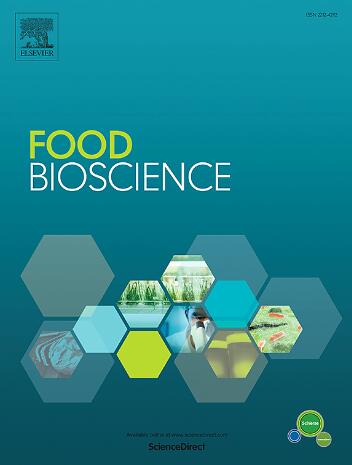Synthesis of an autochthonous microbiota responsible for the prepared process improving, flavor profile and brewing attributes of high-temperature Daqu
IF 4.8
1区 农林科学
Q1 FOOD SCIENCE & TECHNOLOGY
引用次数: 0
Abstract
We developed a synthetic autochthonous microbiota from traditional high-temperature Daqu (CQ) to produce clean Daqu (XQ) under relatively controlled conditions. Comparative analyses revealed that XQ replicated 82.35 % of CQ's flavor components, as determined by Gas Chromatography-Mass Spectrometry (GC-MS), while reducing the levels of hazardous compounds such as Ochratoxin A and eliminating substances like 2-ethylhexanol and dimethyl oxalate. XQ exhibited physicochemical dynamics (temperature, acidity, enzyme activity) mirroring CQ during fermentation, achieving a peak temperature >60 °C characteristic of high-temperature processing. Microbial analysis showed XQ was dominated by Bacillus (92.23 % in bacteria) and Aspergillus (95.13 % in fungi), contrasting with CQ's diverse community (28.11 % Thermoactinomyces, 19.30 % Burkholderia). Clusters of Orthologous Groups of proteins (COG) functional profiling demonstrated XQ's enhanced carbohydrate metabolism (p < 0.05), critical for flavor synthesis, while maintaining essential fermentation functions. Notably, XQ retained key pyrazines (Maotai-flavor markers) at higher levels than CQ, linked to Oceanobacillus dominance (3.18 %). E-nose analysis confirmed 85.71 % flavor similarity between XQ and CQ, with reduced sulfides (S2/S12 sensors, p < 0.05). This study pioneers a controlled microbiota-driven approach for Daqu production, achieving biosafety without compromising functionality, offering a paradigm for cleaner and more stable fermented food manufacturing.
对高温大曲制备工艺改进、风味特征及酿造特性有重要影响的原生菌群的合成
我们从传统的高温大曲(CQ)中开发出一种合成自生微生物群,在相对可控的条件下生产出洁净大曲(XQ)。比较分析表明,通过气相色谱-质谱法(GC-MS)测定,XQ 复制了 CQ 82.35 % 的风味成分,同时降低了赭曲霉毒素 A 等有害化合物的含量,并消除了 2-乙基己醇和草酸二甲酯等物质。XQ 在发酵过程中表现出与 CQ 类似的物理化学动态(温度、酸度、酶活性),达到高温加工特有的峰值温度 60°C。微生物分析表明,XQ 以芽孢杆菌(占细菌总数的 92.23%)和曲霉菌(占真菌总数的 95.13%)为主,与 CQ 的多样性群落(28.11% 热乳酸菌,19.30% 伯克霍尔德菌)形成鲜明对比。蛋白质同源群(COG)功能分析表明,XQ 的碳水化合物代谢能力增强(p < 0.05),这对风味合成至关重要,同时还保持了基本的发酵功能。值得注意的是,XQ 比 CQ 保留了更高水平的关键吡嗪(茅台酒风味标志),这与海洋杆菌优势(3.18%)有关。电子鼻分析证实,XQ 和 CQ 的风味相似度为 85.71%,硫化物含量降低(S2/S12 传感器,p < 0.05)。这项研究开创了一种受控微生物群驱动的大曲生产方法,在实现生物安全的同时不影响其功能,为更清洁、更稳定的发酵食品生产提供了一种范例。
本文章由计算机程序翻译,如有差异,请以英文原文为准。
求助全文
约1分钟内获得全文
求助全文
来源期刊

Food Bioscience
Biochemistry, Genetics and Molecular Biology-Biochemistry
CiteScore
6.40
自引率
5.80%
发文量
671
审稿时长
27 days
期刊介绍:
Food Bioscience is a peer-reviewed journal that aims to provide a forum for recent developments in the field of bio-related food research. The journal focuses on both fundamental and applied research worldwide, with special attention to ethnic and cultural aspects of food bioresearch.
 求助内容:
求助内容: 应助结果提醒方式:
应助结果提醒方式:


